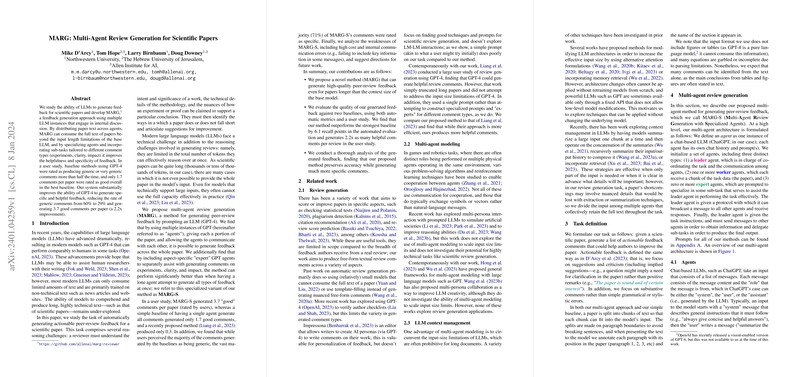Overview
The multi-agent review generation method, MARG-S, has introduced a means to tackle one of the recent challenges posed by the limitations of LLMs such as GPT-4. This innovative approach delegates the task of generating peer review feedback on scientific papers across multiple instances of a LLM. By distributing the text among several "agents," each handling a fragment and communicating with others, MARG-S can handle longer texts effectively. It enhances specificity and helpfulness in feedback by specializing agents to focus on specific aspects of critique such as experimentation, clarity, and impact.
System Design
MARG-S's architecture consists of a designated leader agent orchestrating the process with multiple worker agents, each provided with a section of the scientific paper, and specialized expert agents focusing on different review aspects. The coordination relies on a communication protocol, allowing agents to exchange messages to gather insights across the paper's entirety. The method also includes a crucial refinement stage where initial feedback undergoes a polishing process, improving clarity and ensuring comments are contextually relevant prior to presenting to the user.
User Study Evaluation
In the MARG-S evaluation through a user paper, the multi-agent approach showed a remarkable improvement in the quality of generated comments compared with the baseline methods. Feedback from users suggested MARG-S offered specific, accurate, and actionable suggestions. However, while MARG-S surpassed other methods in producing "good" comments, broadly beneficial improvements are still possible, indicated by a notable proportion of comments being deemed as "bad" or "highly inaccurate" across all methods.
Potential and Challenges
The introduction of MARG-S into the domain of scientific review generation reflects a promising leap forward. It not only showcases an advanced application of LLMs but also exhibits a potential model for future enhancement of AI-driven peer-review systems. The increase in the cost of running such multi-agent systems, however, points toward a significant consideration for practical deployment. Future iterations of MARG-S will benefit from optimization for cost and efficiency, the inclusion of related literature for more informed reviews, and advancements in managing the agent communication to handle even larger inputs without overwhelming the system’s capacity. With further refinement, systems like MARG-S could significantly aid scientific communities in the review process, offering more comprehensive, insightful feedback to authors and potentially reshaping the peer review landscape.
